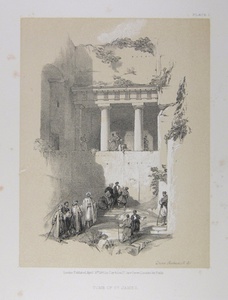| Method | Lithograph with tint stone |
| Artist | after David Roberts |
| Published | London, Published April 16th. 1855, by Day & Son, 17, Gate Street, Lincoln's Inn Fields |
| Dimensions | Image 172 x 132 mm, Sheet 285 x 202 mm |
| Notes |
Plate 5 from Volume 1 of the small format reprint of Roberts' The Holy Land, Syria, Idumea, Arabia, Egypt & Nubia. A view of the so-called Tomb of St James, probably the Tomb of Beni Hezir in the Kidron Valley, Jerusalem. The rock-cut tomb of Beni Hezir was built during the second century BC for a family of priestly class. The tomb is typical of the Hellenistic style popular with the Hasmoneans, with a Doric facade of a pair of columns between two pilasters. By contrast, the tomb of the biblical Saint James the Less is part of the Cathedral of Sts. James, the principle church of the Armenian Patriarchate of Jerusalem. St James, usually referred to as James the Less or the Just to differentiate him from St James the Greater, was a key figure of the Apostolic Age and bishop of Jerusalem. In some traditions, he is known as the 'brother of Jesus,' though interpretation of this title varies. In Roberts' view, the facade of the Tomb of Beni Hezir and the courtyard below are populated with groups of men in middle-eastern dress. A guard, wearing a fez and with a rifle resting against his crossed arms, leans against a side wall of the courtyard. David Roberts RA (24th October 1796 – 25th November 1864) was a Scottish painter. He is especially known for a prolific series of detailed prints of Egypt and the Near East produced during the 1840s from sketches made during long tours of the region (1838-1840). This work, and his large oil paintings of similar subjects, made him a prominent Orientalist painter. He was elected as a Royal Academician in 1841. The firm of Day & Haghe was one of the most prominent lithographic companies of the nineteenth-century. They were also amongst the foremost pioneers in the evolution of chromolithography. The firm was established in 1823 by William Day, but did not trade under the moniker of Day & Haghe until the arrival of Louis Haghe in 1831. In 1838, Day & Haghe were appointed as Lithographers to the Queen. However, and perhaps owing to the fact that there was never a formal partnership between the two, Haghe left the firm in the 1850's to devote himself to watercolour painting. The firm continued as Day & Son under the guidance of William Day the younger (1823 - 1906) but, as a result of a scandal involving Lajos Kossuth, was forced into liquidation in 1867. Vincent Brookes bought the company in the same year, and would produce the caricatures for Gibson Bowles' Vanity Fair magazine, as well as the illustrations for Cassells's Poultry Book, amongst other commissions. Condition: Light foxing to margins, not affecting image. |
| Framing | unmounted |
| Price | £25.00 |
| Stock ID | 39255 |

